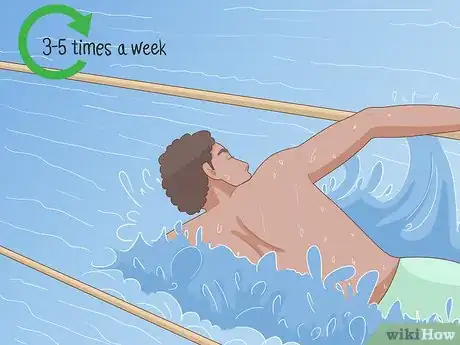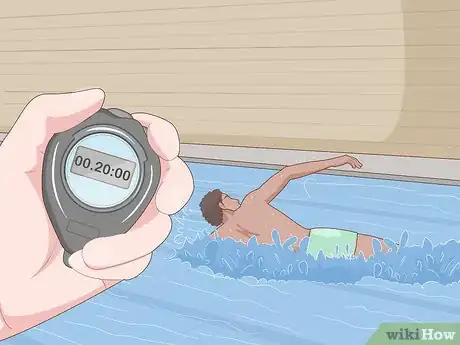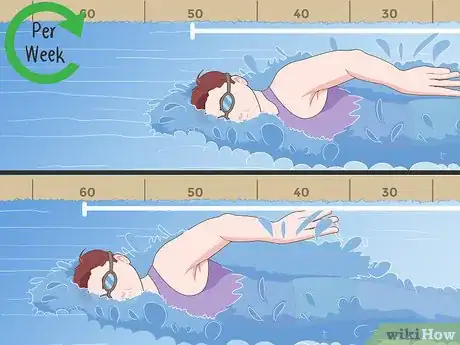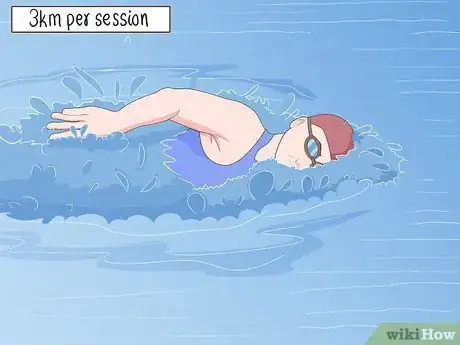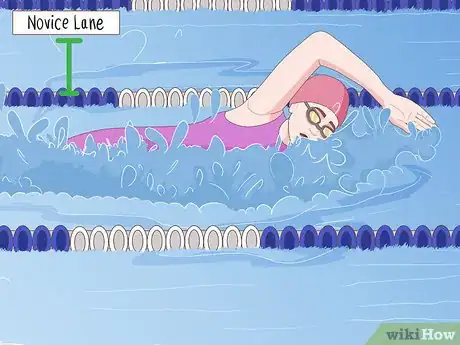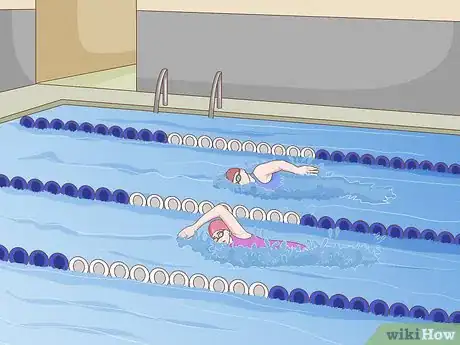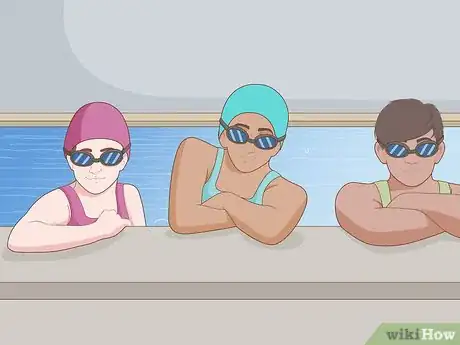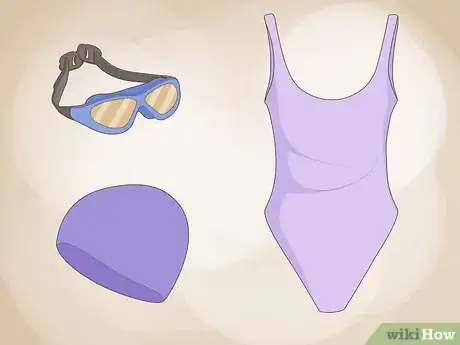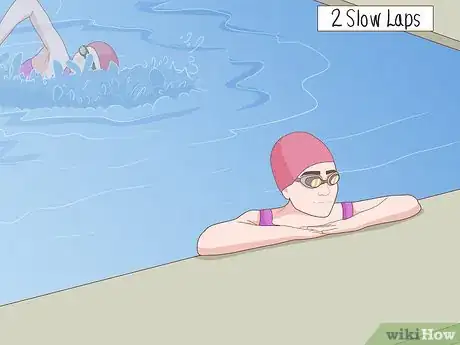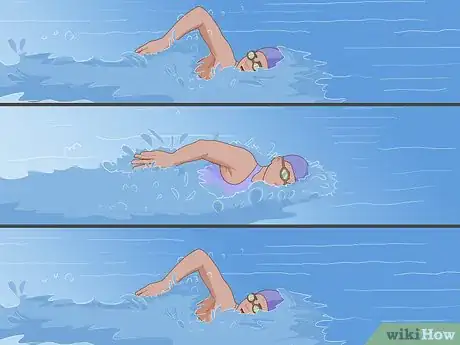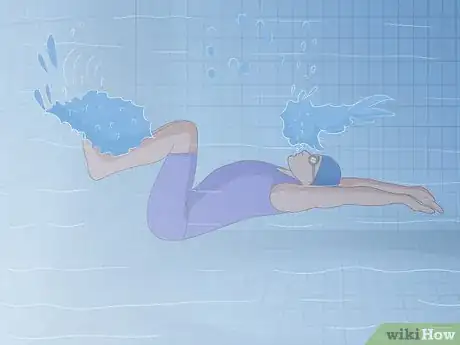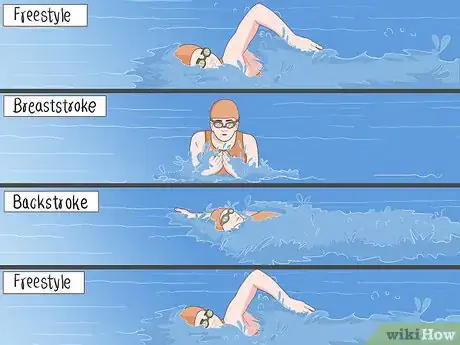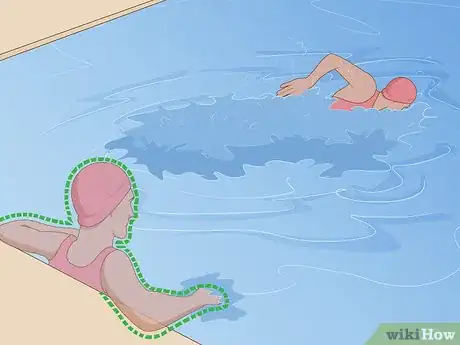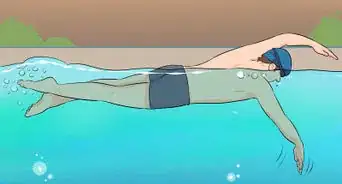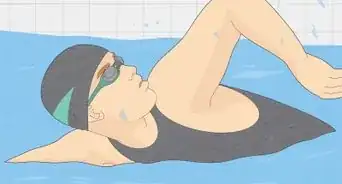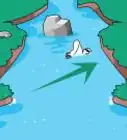This article was co-authored by Brad Hurvitz. Brad Hurvitz is a Certified Swimming Instructor for My Baby Swims, an adolescent swimming school based in La Jolla, California. Brad is trained as an Infant Swimming Resource (ISR) instructor with ISR's Self-Rescue® program. He specializes in training children aged six months to six years of age survival skills like floating on their back to breathe and swimming back to the wall, while also educating parents on how to better keep their kids safe. He has a Master of Business Administration from Oregon State University.
This article has been viewed 43,307 times.
Swimming is a great way to get fit, lose weight, and tone your muscles. It is best to start your swimming routine slowly and then gradually increase the length and duration of your swims. To keep your routine interesting, try using different strokes and set yourself goals. Before you start swimming, try to get acquainted with the basic etiquette and consider joining a club or getting lessons.[1] If you want to swim 1,000 metres (3,300 ft), try using the sample swim plan to get you started. Enjoy your swimming journey!
Steps
Creating a Swimming Routine
-
1Aim to swim 3 - 5 times a week. This amount of training helps to improve your strength and fitness, which allows you to swim further and faster each week.[2] Make sure to take rest days each week, as this allows your body to recover and build muscle mass. This frequency of swimming is great for both weight loss and competitive training.[3]
- If you find that your muscles are getting really sore, start by swimming 3 times a week and then increase the frequency of your swims once your muscles get used to the routine.
-
2Start and finish each work out with a warm up and cool down. This helps to prevent injuries and sore muscles. Try to slowly swim about 100 metres (330 ft) before you get into your swimming programme and then swim a similar distance after you finish your training. Make sure to swim in a slow, relaxed manner to help gently stretch your muscles.[4]
- If you are unable to swim 100 metres (330 ft) when you start out, try swimming 25 metres (82 ft) or 50 metres (160 ft) until your fitness increases.
- These laps are the same as the ones that you complete during your workout; however, they are designed to be swam more slowly.
Advertisement -
3Begin by swimming as far as you can in 20 minutes. This allows you to assess your initial fitness. Record how far you swim in 20 minutes for your first 2 or 3 swims to give you an accurate idea of your starting abilities. If the pool is 50 metres (160 ft), multiply the number of laps that you swam by 50 metres (160 ft) to calculate your distance. Don’t be disheartened if you can’t swim very far – you will quickly improve![5]
- Use a stopwatch to time your workouts. If you don’t have a stopwatch, use the swim timer on the wall to time your swim.
- If you can easily swim for 20 minutes swim for 30 minutes instead.
- Don’t worry if you need to rest between laps at first, this is normal! Over time, you will be able to swim longer distances with fewer breaks.
-
4Increase your distance by 10% each week. It is best to increase the distance that you swim slowly, as this helps to prevent injuries that occur as a result of over-exertion. This will also help to keep you motivated, as the increased distances shouldn’t feel overwhelming. Don’t worry about how fast you swim, simply try to increase your distance each week. As you increase the distance of your swims, your workouts will gradually get longer.[6]
- If you prefer, you can increase the length of your workout by 10% instead. Over time, this will also increase the distance of your swims.
-
5Incorporate different strokes into your routine to add variety. If you find freestyle a little monotonous, try adding breaststroke, backstroke, side-stroke, and butterfly into your routine. These will help to make your workouts more interesting and will also help to strengthen different muscles.[7]
- If you aren’t confident at swimming different strokes, try doing a few lengths with just kicking or just using your arms to mix up your routine.
- Working with an instructor or coach can be very helpful when incorporating new strokes, as they can observe your form and give you tips on how to improve.[8]
-
6Work toward swimming 3 km (1.86 mi) per session. This amount is regarded as a healthy maximum distance for casual swimmers. Once you can swim 3 km (1.86 mi), try increasing the speed of your swimming to give yourself a new challenge.[9]
- Triathlon swims are normally 1.5 kilometres (0.93 mi) long. If you are training for a triathlon, aim to swim at least 1.5 kilometres (0.93 mi) before the event.
Learning the Basics
-
1Swim in the novice lane until you increase your speed and endurance. Each swimming lane will have a sign in front of it indicating the speed. Swimming in a fast lane if you’re just starting out will be frustrating for both you and those who you’re swimming with. Start in the novice lane and then move up to the next lane once you find the pace of the novice lane too slow.[10]
- Some pools call the novice lane the beginner or the guppy lane.
-
2Swim up 1 side of the lane and back down the other. If there are multiple people swimming in 1 lane, it is etiquette to swim up 1 side and then back on the other in a circular rotation. This helps to stop collisions in the lanes and makes it safer and easier for people to swim.[11]
- Swim on the same side of the lane that you would drive on. For example, if you live in America, swim on the right side and if you live in New Zealand, swim on the left side.
-
3Join a swimming group to help you keep motivated. This is a great way to meet some like-minded friends and to help keep up your enthusiasm. Ask your local pools if they have a swimming group that meets regularly. Most pools will have both social and competitive groups.[12]
- If your local community doesn’t have a swimming group, consider starting one with some friends.
-
4Consider attending a few swimming lessons to improve your technique.[13] If this is your first time swimming or you’re recovering from injuries, try taking a few lessons to help you learn the basics and avoid injuries. Swimming lessons range from $20-100 per lesson.[14]
- Enquire at your local pools about swimming lessons.
-
5Start with basic gear, including a bathing suit and goggles. Don’t worry about splashing out and spending lots of money on fancy equipment. All you need to get started is a bathing suit, goggles, and a swim cap if you have long hair. Purchase swimming gear from the pools or a sports store.[15]
- If you get sore ears, try wearing swimming ear plugs to keep the water out of your ears.
Following a 1,000 m (3,300 ft) Swim Plan
-
1Swim 2 slow laps and then catch your breath. This warms up your muscles and helps to prevent your body from feeling sore later. Complete the laps in whatever stroke you wish. Don’t worry about trying to swim fast, simply allow your body to warm up.[16]
- This swimming plan is designed for a 50 m (160 ft) pool. If you are swimming in a 25 m (82 ft) pool, double the number of laps in this method in order to swim 1,000 m (3,300 ft) pool.
-
2Alternate between 1 fast lap and 1 easy lap of freestyle 5 times. Swim 1 lap as fast as you can and then swim a slow recovery lap. This helps to increase your heart rate and your anaerobic fitness. If possible, try not to have breaks between each set of fast and slow laps.[17]
- If you need to, take a short break to catch your breath after you’ve completed 5 sets.
-
3Swim 2 laps of just kicking. Push off the wall with your feet and let your arms hang by your side. Kick your feet as hard as you can to propel yourself through the water. This helps to strengthen your leg muscles.[18]
-
4Complete 4 laps of different strokes. Try to swim 4 laps without stopping. Use different strokes to help work out different muscles in your body. Experiment with breaststroke, backstroke, and freestyle. Alternate between different strokes to give your muscles a break.[19]
- For example, swim 1 lap of freestyle, 1 lap of breaststroke, 1 lap of backstroke, and then 1 lap of freestyle.
-
5Catch your breath and then swim 2 slow laps. Allow your body to regulate your breathing back to a normal speed. Then, swim 2 laps really slowly to help your body cool down. This helps to prevent injuries and sore muscles.[20]
- Congratulations, you’ve swum 1,000 metres (3,300 ft)!
Expert Q&A
-
QuestionWhat exercises can I do to get better at swimming?
 Brad HurvitzBrad Hurvitz is a Certified Swimming Instructor for My Baby Swims, an adolescent swimming school based in La Jolla, California. Brad is trained as an Infant Swimming Resource (ISR) instructor with ISR's Self-Rescue® program. He specializes in training children aged six months to six years of age survival skills like floating on their back to breathe and swimming back to the wall, while also educating parents on how to better keep their kids safe. He has a Master of Business Administration from Oregon State University.
Brad HurvitzBrad Hurvitz is a Certified Swimming Instructor for My Baby Swims, an adolescent swimming school based in La Jolla, California. Brad is trained as an Infant Swimming Resource (ISR) instructor with ISR's Self-Rescue® program. He specializes in training children aged six months to six years of age survival skills like floating on their back to breathe and swimming back to the wall, while also educating parents on how to better keep their kids safe. He has a Master of Business Administration from Oregon State University.
Certified Survival Swimming Instructor For adults, I highly recommend rowing. Rowing, just like swimming, is a full-body workout. It is also not difficult on the joints. There are a lot of similarities between rowing and swimming.
For adults, I highly recommend rowing. Rowing, just like swimming, is a full-body workout. It is also not difficult on the joints. There are a lot of similarities between rowing and swimming. -
QuestionCan I learn how to swim competitively on my own?
 Alan FangAlan Fang swam competitively for over 7 years, through high school and into college. He specialized in breaststroke events, and participated in events such as the Speedo Championship Series, the IHSA (Illinois High School Association) state championships, and Illinois Senior and Age Group state championships.
Alan FangAlan Fang swam competitively for over 7 years, through high school and into college. He specialized in breaststroke events, and participated in events such as the Speedo Championship Series, the IHSA (Illinois High School Association) state championships, and Illinois Senior and Age Group state championships.
Former Competitive Swimmer Learning how to swim really requires a lot of outside guidance. If you’re just getting started, the most important thing to do is get a coach or join a team. You need someone standing from the side to observe issues with your strokes.
Learning how to swim really requires a lot of outside guidance. If you’re just getting started, the most important thing to do is get a coach or join a team. You need someone standing from the side to observe issues with your strokes.
Warnings
- Consult with your doctor before starting a swimming programme if you have been unwell recently.⧼thumbs_response⧽
References
- ↑ Alan Fang. Former Competitive Swimmer. Expert Interview. 10 January 2019.
- ↑ Alan Fang. Former Competitive Swimmer. Expert Interview. 10 January 2019.
- ↑ https://www.active.com/swimming/articles/get-into-shape-with-these-basics-of-swim-training
- ↑ https://www.active.com/swimming/articles/get-into-shape-with-these-basics-of-swim-training
- ↑ https://www.active.com/swimming/articles/get-into-shape-with-these-basics-of-swim-training
- ↑ https://www.usms.org/content/startingaroutine
- ↑ https://www.active.com/swimming/articles/get-into-shape-with-these-basics-of-swim-training
- ↑ Alan Fang. Former Competitive Swimmer. Expert Interview. 10 January 2019.
- ↑ https://www.active.com/swimming/articles/get-into-shape-with-these-basics-of-swim-training
- ↑ https://www.nomeatathlete.com/swim-training/
- ↑ https://www.usms.org/content/startingaroutine
- ↑ https://www.usms.org/content/startingaroutine
- ↑ Alan Fang. Former Competitive Swimmer. Expert Interview. 10 January 2019.
- ↑ https://www.usms.org/content/startingaroutine
- ↑ https://www.active.com/swimming/articles/7-tips-for-swimming-newbies
- ↑ https://www.active.com/swimming/articles/get-into-shape-with-these-basics-of-swim-training
- ↑ https://www.active.com/swimming/articles/get-into-shape-with-these-basics-of-swim-training
- ↑ https://www.active.com/swimming/articles/get-into-shape-with-these-basics-of-swim-training
- ↑ https://www.active.com/swimming/articles/get-into-shape-with-these-basics-of-swim-training
- ↑ https://www.active.com/swimming/articles/get-into-shape-with-these-basics-of-swim-training

